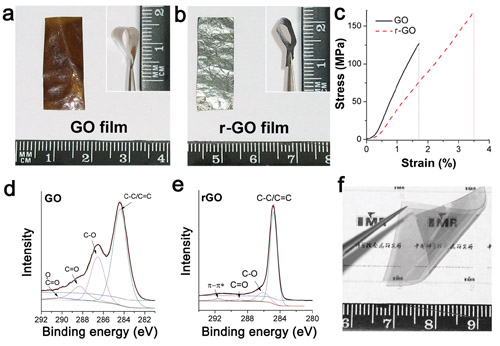Based on the understanding of the chemical structure of GO, the possible mechanism of halogenation reactions and the properties of carbon-halogen bonds, Advanced Carbon Division at Institute of Metal Research, Chinese Academy of Sciences developed a simple but highly-effective hydrohalic acid reducing method to reduce GO films into highly conductive graphene films. GO films reduced in 55% hydroiodic (HI) acid have an electrical conductivity as high as 3×104 S/m and a C/O ratio above 12, both of which are much higher than films reduced by other chemical reducing methods. More importantly, this reducing method maintains good integrity and flexibility, and even improves the strength and ductility, of the original GO films. Using this reducing method, a flexible graphene-based TCF with a sheet resistance of around 1 kΩ/□ at transparency of 84% was obtained. Highly-effective reduction combined with good mechanical properties of the reduced GO films can not only facilitate the large-scale production and application of large-area graphene-based conductive films, but is also a valuable method for the large-scale production of graphene by reducing GO.
Since discovery in 2004, graphene has attracted great interest due to its unique structure, novel properties and great potential in various applications. Graphene oxide (GO), a graphene derivative, can be obtained through chemical oxidation and exfoliation of graphite and then converted into graphene through reducing treatment. It has become a valuable way for the mass-production and applications of graphene using GO as precursor. Graphene-based transparent conductive films (TCFs), which are anticipated to replace traditional indium doped tin oxide (ITO) films in future bendable electronic and optoelectronic devices, can also be fabricated by reducing GO films in a cost-effective manner, since GO have exceptionally low cost and can easily be assembled into large-area films by simple solution processes. The largest obstacle, nevertheless, is how to effectively reduce GO to remove the oxygen-containing functional groups on GO and make the reduced GO highly conductive.
Generally, there are two approaches to realize the reduction of GO: high temperature thermal annealing and low temperature chemical reduction. The former is highly effective but usually needs a temperature above 1000°C; while the latter can be realized at a temperature lower than 100 °C, which is extremely important for practical applications, since graphene films are commonly supported on substrates such as glass and plastics that cannot stand high temperature. However, the chemical reducing effect reported by now using hydrazine or hydride (e.g. NaBH4 and LiAlH4, etc.) is far from satisfactory; furthermore, hydrazine and its derivatives are heavy toxic reagents, the mass use of which will result in severe pollution to the environment. Moreover, many researches have proved that these reducing reagents are not suitable for the reduction of GO films, especially for those needing high flexibility for applications in flexible devices, due to the stiffening and disintegrationof the films during reduction. Therefore, a more effective strategy must be developed to reduce GO without destroying the original high flexibility and integrity of GO films.
This work achieved the reduction of GO by strong acidic reagent instead of well-acknowledged alkali reagent, and a nucleophilic substitution reaction is presumed to be the basic process of GO reduction by chemical routes, which is important to understand the mechanism of chemical reduction of GO, develop new reducing technique and explore new applications of GO and graphene. The related results were recently published in Carbon and ACS Nano (website link: http://dx.doi.org/10.1016/j.carbon.2010.08.006 and http://pubs.acs.org/doi/abs/10.10 21/nn1015506).